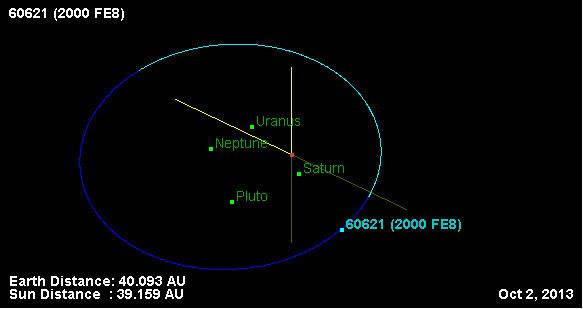Discovery date 27 March 2000 Alternative names 2000 FE8 Observation arc 2485 days (6.80 yr) Absolute magnitude 6.9 | MPC designation (60621) 2000 FE8 Minor planet category SDO · TNO Discovered 27 March 2000 Discovery site Mauna Kea Observatories | |
 | ||
Discovered by J. KavelaarsB. GladmanJ.-M. PetitM. Holman Discoverers Jean-Marc Petit, John J. Kavelaars, Brett J. Gladman, Matthew J. Holman Similar Brett J Gladman discoveries, Other celestial objects | ||
(60621) 2000 FE8 is a scattered-disk object that resides in a distant, eccentric orbit that brings it 1.1 to 2.6 times farther than Neptune. This object is locked in a 2:5 orbital resonance with Neptune. It is known to have a single moon, S/2007 (60621) 1.
Contents
Orbit
2000 FE8 has an extremely eccentric which crosses the paths of many other trans-Neptunian objects, including almost all of the dwarf planets and dwarf planet candidates. As a result, its position alternates between the Kuiper Belt and the Scattered disk.
Resonance with Neptune
2000 FE8 is part of a group of trans-Neptunian objects that orbit in a 2:5 resonance with Neptune. That means that for every five orbits that Neptune completes, 2000 FE8 makes only two. Several other objects are in the same orbital resonance, the largest of which is (84522) 2002 TC302.
Moon
Like many objects of the Kuiper Belt and Scattered Disk, 2000 FE8 has a moon. This moon, S/2007 (60621) 1, was discovered by the Hubble Space Telescope seven years after 200 FE8 itself was found. The moon orbits at 1180 kilometres away from 2000 FE8, completing one orbit every week. It is thought to be 115 km in diameter, just 75.7% the diameter of 2000 FE8 itself. From the surface of 2000 FE8, S/2007 (60621) 1 would have an apparent diameter of roughly 6°, twelve times larger than the Sun appears from Earth.
